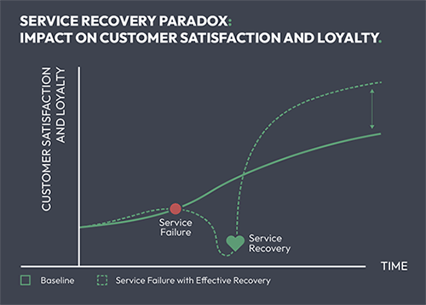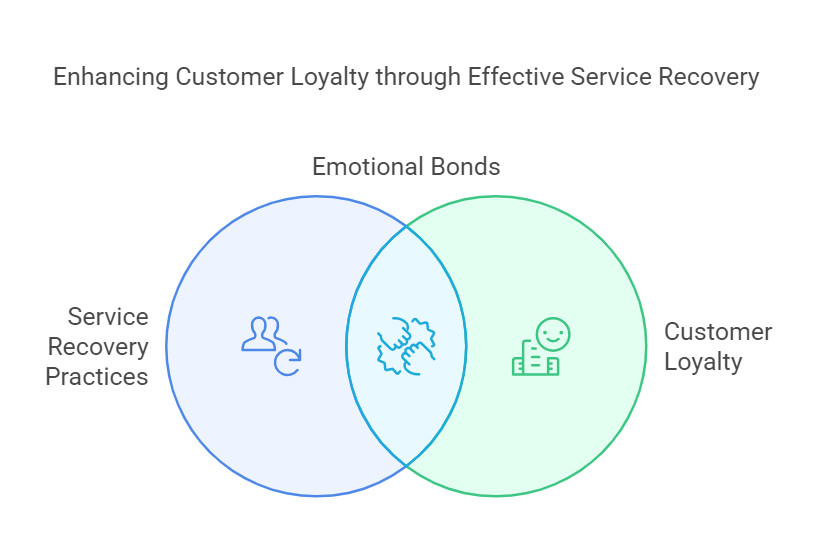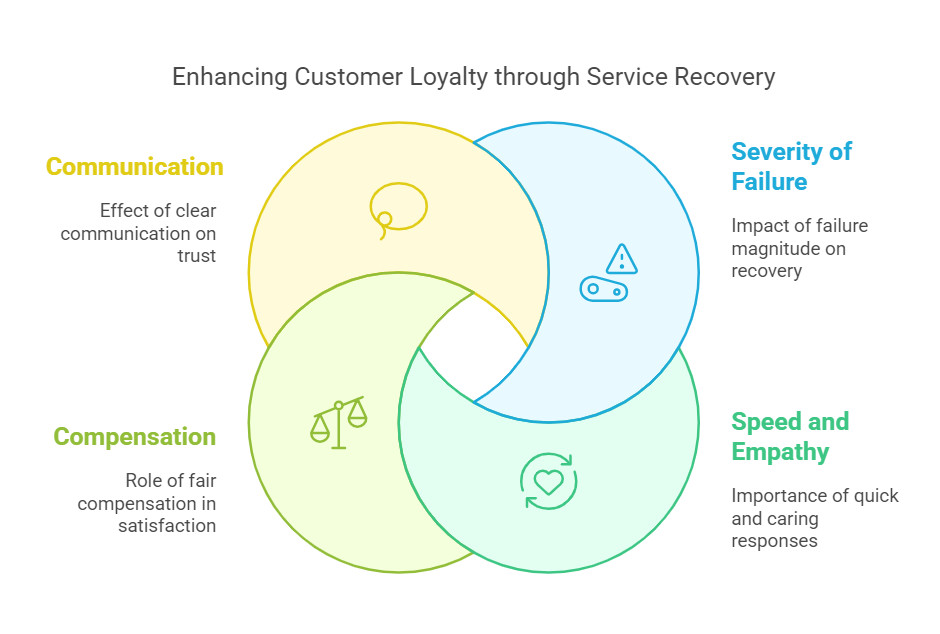- Research platform
Sources of information
Data analysis
Actions
- Solutions
For whom
Problems / Issues
- Materials
Materials
- About us
About us

Can fixing mistakes increase customer loyalty? This question sits at the core of the service recovery paradox, which shows that addressing customer complaints effectively can lead to more loyalty than if no issues had occurred. This post examines dynamics of service recovery. Additionally, leveraging customer data collected through various touchpoints can provide insights into customer needs and preferences, enabling businesses to enhance their service recovery strategies and improve customer loyalty. We cover why customer satisfaction surveys remain crucial in understanding and enhancing customer loyalty.
By looking closely at factors affecting SRP outcomes, we uncover ways businesses can use customer feedback. This feedback turns negatives into lasting loyalty. We explore why resolving issues is not just an opportunity to correct things but also a way to strengthen ties with customers. Join us to reveal the relationship between service recovery and customer loyalty, while offering insights to improve your customer experience strategy.
The service recovery paradox is an interesting aspect of customer service. When service fails, effective recovery can make customers more loyal than before. When businesses swiftly address problems through fast responses, compensation, or sincere apologies, they can enhance customer satisfaction.
This surprising outcome relates to the view customers have of recovery. If a company not only fixes a mistake but does it in a way that exceeds expectations, loyal customers emerge. For example, those whose complaints are well-managed can express satisfaction levels that are 70% higher than those who never faced issues at all.
Ensuring high service quality is also crucial, as it influences customer satisfaction and sets the stage for effective service recovery. To utilize the service recovery paradox well, knowing customer expectations is important. During a service failure, recovery expectations greatly vary. A fast response counts a lot. Research shows customers appreciate when a company works hard to fix their problems. Timely solutions build trust, which can lead to stronger loyalty.
In conclusion, the service recovery paradox shows that mistakes can affect customer satisfaction negatively. However, good recovery efforts can correct issues and boost loyalty above previous levels. In the end, what a customer feels matters a lot.
Shifting to another important part of this subject involves looking at service recovery dynamics and their effects on customer loyalty. Analyzing these factors reveals key parts of successful recovery efforts and highlights their lasting impact on customer views.

There is a complex relationship between service recovery practices and customer loyalty. Companies using service recovery do more than rectify an error; they can enhance customer loyalty by fostering strong emotional bonds with customers. The service recovery paradox suggests that customers who face a problem followed by a skillful handling can exhibit a higher loyalty level than if no problems had happened. This paradox shows that when customers feel appreciated due to effective handling of issues, it can boost their trust and attachment to the brand.
Emotional and psychological aspects significantly impact customer loyalty after recovery. When customer issues get resolved properly, it generates satisfaction that goes beyond the initial frustrations. This satisfaction links to how much effort the business puts into fixing the problem. About 70% of customers say they remain loyal to a brand that successfully addressed their complaint. This finding highlights how crucial it is for customers to view service recovery actions as effective, as these actions influence their feelings and connections with the brand.
Analyzing customer retention metrics can provide valuable insights into the effectiveness of service recovery efforts and help businesses develop strategies to further enhance customer loyalty.
Communication and follow-up are vital in the service recovery dynamics. Companies reaching out to customers post-recovery, checking in on their satisfaction and resolving further issues, improve customer retention significantly. A remarkable 80% of customers say they appreciate follow-up messages after a service issue. This proactive approach reinforces the customer’s choice to return and strengthens their relationship with the brand, showing the business values their input and needs.
In summary, service recovery dynamics and customer loyalty provide brands an important chance to not only regain customers but also to enhance their emotional connections. When customers know their concerns are taken care of, it fosters advocacy for the brand and shows renewed loyalty. As we proceed to discuss the critical factors that influence service recovery paradox outcomes, it’s necessary to dive deeper into the reasons that can boost or weaken service recovery effectiveness.
The service recovery paradox can greatly affect customer loyalty. How a business manages its service failures matters to customers. Many factors influence how these recovery efforts perform. These actions indicate whether customers feel a stronger connection to a brand after failures and can significantly enhance customer loyalty.
The degree of service failure is very important for recovery results. Small issues usually do not need much to fix, but big failures may cause greater dissatisfaction. Its crucial for companies to match recovery efforts to the failure severity for restoring trust.
Fast responses and empathetic actions when issues occur are critical. Timely solutions and personal care are what customers anticipate. Research shows that 70% of customers feeling listened to during recovery would likely come back. This proves that speed and empathy play major roles in pleasing customers.
Next, the perceived value of compensation affects how customers view the situation. If compensation fits what customers expect from a service failure, satisfaction increases. Reports state 50% of consumers seek fair compensation when issues arise. Therefore, firms must adjust their recovery offerings accordingly for optimal results.
Communication is very essential in setting customer expectations during recoveries. Being clear and open about problems, actions taken for fixing them, and what customers can expect builds trust. Companies practicing effective communication in their recovery can see 20% better customer loyalty scores.
In conclusion, crucial factors like handling service failures’ magnitude, swift empathetic responses, suitable compensation, and solid communication affect the service recovery paradox outcomes. Knowing these aspects helps businesses use customer satisfaction surveys effectively to strengthen customer loyalty.
As we move forward, it’s necessary to examine how customer satisfaction surveys reveal these factors. They also assist businesses in assessing the success of their recovery methods.

Meeting customer expectations is crucial for building trust and loyalty. When customers feel that their expectations are met, they are more likely to return and recommend the business to others. To meet customer expectations, businesses must first understand what those expectations are. This can be done through customer feedback, surveys, and data analysis.
Customer satisfaction surveys are important for businesses wanting to improve service recovery and boost customer loyalty. After a service failure, these surveys offer valuable customer feedback that helps companies assess how well they handled recovery and if customers are satisfied with the results, ultimately aiming to enhance customer satisfaction.
A main advantage of customer satisfaction survey is helping to find service failure patterns. Companies can analyze the survey data to discover issues affecting customer satisfaction. For example, if several customers mention the same problem after a service failure, it becomes a priority for fixing to prevent it from happening again.
Surveys do more than spot issues; they measure customer feelings regarding service failures. Research shows that a good number of customers, up to 70%, forgive a company when recovery exceeds their hopes. This finding highlights the importace of knowing not just what went wrong, but also how customers viewed the resolution.
In addition, customer satisfaction surveys help businesses check how good their recovery strategies are. Companies can track responses related to recovery perceptions to see which methods succeed in bringing back satisfaction and loyalty. This way of testing helps guide plans for improvement, paving the way for better customer relationships.
In-short, using customer satisfaction surveys helps businesses grasp customers thoughts after recovery and sets the stage for service delivery improvements. As businesses improve their methods based on survey results, they handle the service recovery paradox better and build stronger customer loyalty.
Service recovery is key for customer relations, especially when it comes to customer loyalty after a service failure. Turning a negative experience into a positive interaction can involve a few important strategies that ultimately enhance customer loyalty.
First, proactive recovery methods should be in place. By identifying potential failures early, companies can significantly reduce customer dissatisfaction. Proactive measures lead to smoother customer journeys, which reinforces loyalty.
Next, it’s good to communicate empathetically during recoveries. Customers need to feel heard. Allowing them to share their frustrations builds trust. Research shows that if customers feel brands truly care, they often become more loyal.
Providing personalized compensation may also boost customer satisfaction after service errors. A tailored approach—like refunds or discounts—can turn unhappy experiences into loyalty. Personalization indicates to customers that a business values them as individuals, fostering brand connection.
Moreover, it’s crucial to train staff for efficient issue resolution. Employees given authority and resources can address problems swiftly, enhancing overall recovery outcomes. Customers who witness quick and effective fixes tend to trust the company more, increasing customer loyalty and satisfaction.
Integrating these strategies helps businesses manage the service recovery paradox. This paradox suggests that happy customers who experience issues resolved effectively may end up more loyal than those who never faced problems. Effective recovery not only enhances short-term satisfaction but also builds long-term loyalty.
Exploring further, it’s important to recognize how platforms like YourCX can play a vital part in improving these customer experience strategies.
YourCX is a top platform for customer experience analytics. It helps organizations manage customer interactions. By using advanced tools, YourCX allows businesses to run effective customer satisfaction surveys that capture the voice of the customer clearly and help enhance customer satisfaction. This feedback is key for understanding customer needs, related to the service recovery paradox.
The platform offers a strong set of tools for creating satisfaction surveys. These surveys measure current performance and show areas needing improvement. Integrating surveys into service recovery helps businesses get insights for better recovery strategies. Knowing customer sentiment after service failure is very important. This helps turn negative experiences to positive ones, which increases customer loyalty.
Insights from YourCX refine recovery strategies. For example, looking at survey results shows how customers feel about service interactions. It highlights areas that caused dissatisfaction. It also reveals what recovery actions would work best. Effective recovery can change 70% of unhappy customers into happy ones. This shows the impact of solid recovery strategies that use good analytics. YourCX helps reduce the immediate effects of service failures. It also builds a foundation for customer loyalty by ensuring recovery efforts meet customer expectations and preferences.
To sum up, service recovery paradox shows that fixing mistakes can boost customer loyalty. By looking at service recovery and its link to satisfaction, businesses can convert bad experiences into chances for growth. Responses, empathy, and active solutions matters for service recovery efforts.
Also, customer satisfaction surveys are very important. They give critical insights into customer experiences and what they expect. Using good strategies for service recovery helps to solve problems and builds strong customer relationships.
It’s time to act: use the strategies we discussed and focus on your customer satisfaction surveys. Tracking feedback is key. Understand service recovery paradox is really important—not just to keep customers, but also to build loyalty. Use these insights, and see how customer relationships improves.
Copyright © 2023. YourCX. All rights reserved — Design by Proformat